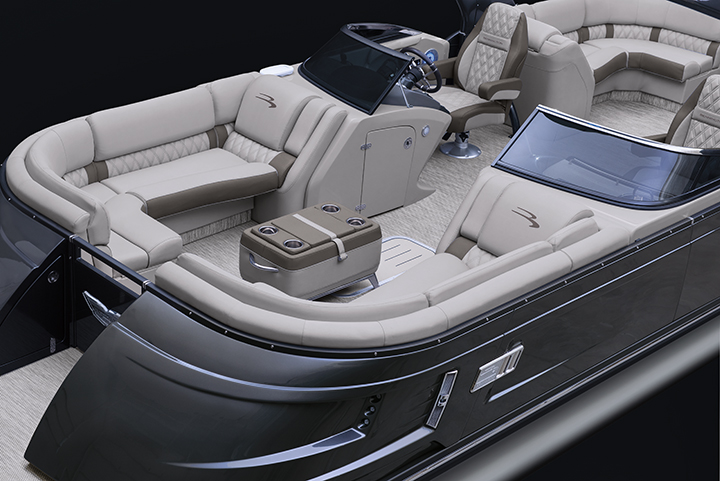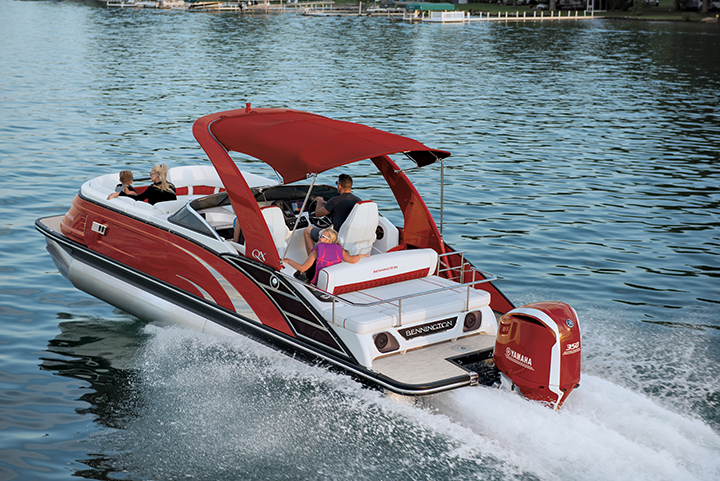Pontoons at play

By David Gee
When Ambrose Weeres, a rural Minnesota farmer and grain mill owner strapped a plywood sheet to two columns of 55-gallon steel drums to create the first pontoon boat in 1951, the idea was a relatively simple one.
“I worked on it and designed the tubes, then a raft, and kept going until I had a boat,” explained Weeres to a local radio station at the time. “The hardest part was making a mount for an outboard motor and designing a steering device.”
No doubt Weeres couldn’t have imagined a pontoon that costs $300,000, or one that could go 100-miles-per-hour, or one that produces surfable waves. For that matter, neither can I. But that’s where we are today, not that many decades later.
When I was growing up, pontoons were something your grandparents owned. And if you had one at the cabin, you probably had another “real” boat to actually do stuff with. There are still plenty of pontoon owners who own another boat and/or a PWC, but also lots of people of all ages who expect their pontoon to do everything, like a waterborne SUV.
“Pontoons always had this stigma about them as just being good for slow cruises around the lake with friends and family,” stated Mark Overbye, CEO of Anthem Marine, and a serial boat building entrepreneur. “But that began to change as they got more comfortable, more powerful and more features. I’m a hardcore watersports enthusiast, but I have also owned pontoons for a couple of decades and always knew they had their place. That place is certainly evolving though.”
Soaring popularity – and prices
Pontoons these days offer better engineering, improved fuel efficiency, increased speed and space and all-around versatility. And that all comes at a higher cost of course.
The first time I saw a six-figure pontoon at my local boat show a few years ago I was kind of taken aback. That’s well south of today’s high-end models such as the Bennington 30 QX triple-tube that can accommodate up to 900-horsepower and can sticker for over $290,000.
Some manufacturers are trying to mitigate sticker shock by offering different levels of pontoon boat lines that target different price points, from entry-level to high luxury.
Whatever the sales strategy is, it seems to be working. The pontoon segment led the industry out of the last recession, and the NMMA says sales of freshwater fishing boats and pontoons accounted for 50% percent of all new powerboats sold in 2020.
For the month of June, 2020, pontoon sales were up 23%, by July they were up 53%, and in August they were up 44% YoY.
Stratview Research estimates that the pontoon boat market will reach $2.5 billion by 2025.
That’s a lot of dinero and a lot of aluminum tubes! So how did we get from 30 to 300K?
“I think back to when I first began building boats,” Overbye told me in a recent Boating Industry Insider podcast episode. “They had analog dashes of course and you could buy gauges for $20-$30. Today you have to put in a large touch screen which can cost a manufacturer $1800 – $1900, and then there’s all the stuff that goes behind it, such as ballast, speed control, etc. That’s just one thing.
“Take fuel systems as another example,” continued Overbye. “I used to buy poly tanks for as little as $50 – $60. Add some tubing and a gas fill and you were good to go. The entire fuel system, including labor, might be less than a couple hundred bucks. Today the fuel tanks we put in our boats are that much just for the tank itself, and our fuel system, depending on some plumbing variables, might be costing us $1200. That’s a big change!”
At Anthem Marine, a relatively new Minnesota-based surf pontoon manufacturer, or designer and builder of “hand-crafted aluminum sport vessels” as the company website refers to them as, their bill of materials is 300 items.
“And you just can’t look at any one thing on that list and say this one thing is a significant driver,” Overbye added. “It all adds up to boats that cost a lot of money. Expectations have changed. People today expect their boats to be as quiet and smooth as their car and there are costs associated with that.”
Overbye says his profit margins are similar to what they were back in the day, it’s just that everything has gone up.
“Let’s also look at the cost of assembling all of those expensive parts. When I started in this business, I could get a finished boat out the door with just 80 – 100-man hours. Today with our Anthem boats we are north of 500-man hours.”
Costs are only going up. The trade-off is whether a particular customer can live with less. If they can, then maybe you can have some lower price points.
Electrification
One way to lower the cost of a pontoon is to hit delete on one, two or three high-output, high-dollar outboards.
“Pontoon boats are particularly well-matched to electric power,” said Torqeedo Inc. president, Steve Trkla. “The reason electric propulsion works so well with pontoons is because of its high torque. It has the power to move a large load easily. At the same time, battery technology continues to develop at a rapid pace, which allows more power and greater run times while taking up less space in the boat.”
Trkla says in some areas they have heard of lakes where gas is no longer available on the water, because the cost of meeting new environmental regulations is so high the marina just said forget it.
“We’re going to see this come up more and more,” Trkla continued. “We expect demand for electric outboards will continue to grow, and most of those engines will likely be pushing pontoons.”
“Our industry is going to continue to evolve, in some very positive ways for boaters I believe,” Overbye said in the podcast. “But it’s also the responsibility of boat builders to pay attention, keep pace with all these changes in technology and customers and the way boats are sold today, to keep things moving in the right direction. The whole pontoon category value proposition is pretty enticing. And I don’t see it slowing down.”






